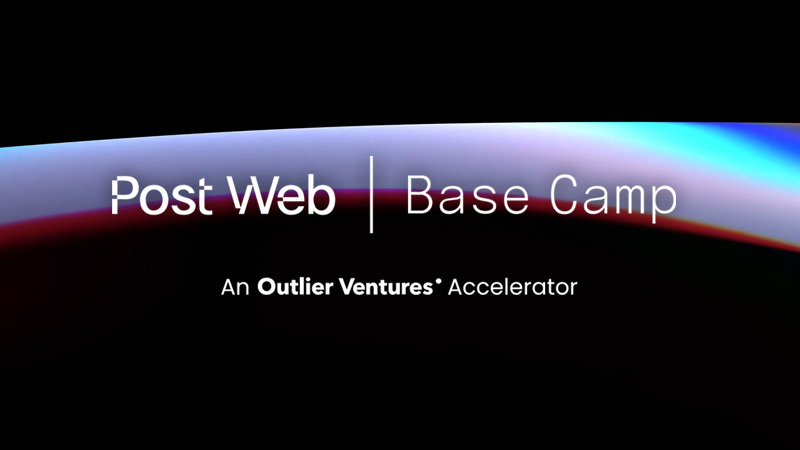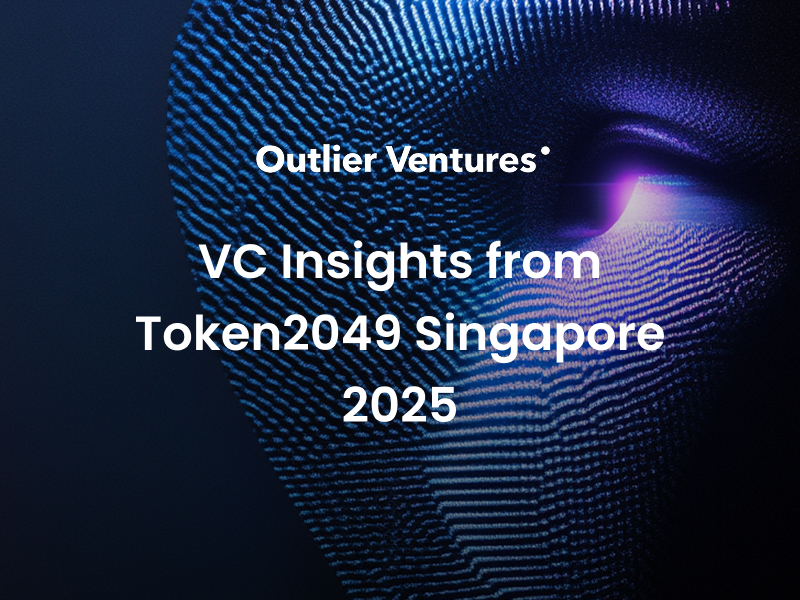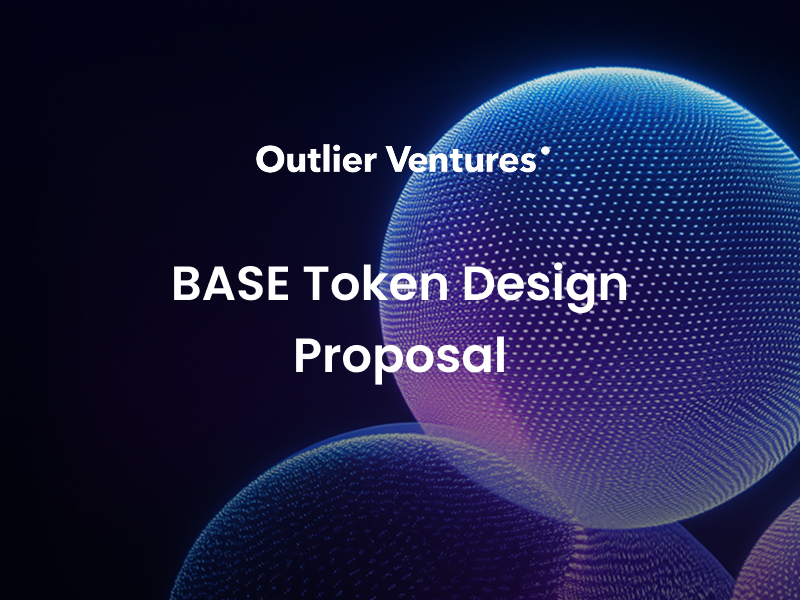Welcome back to our blog series for founders building at the frontier of AI and Web3. In each edition, we explore the emerging trends shaping the next era of the internet, and how our accelerator is helping early teams turn theory into product.
Authors: Jasper De Maere | X | LinkedIn | Greysen Cacciatore | X | LinkedIn
The Post Web is not just introducing a new stack, it is paving the way for a new kind of internet user.
In the era we’re entering, interfaces are replaced by intent, and users are no longer the ones directly clicking, swiping, and transacting. Instead, they’ll delegate that responsibility to autonomous agents capable of executing tasks, making decisions, and interacting across decentralized systems on our behalf.
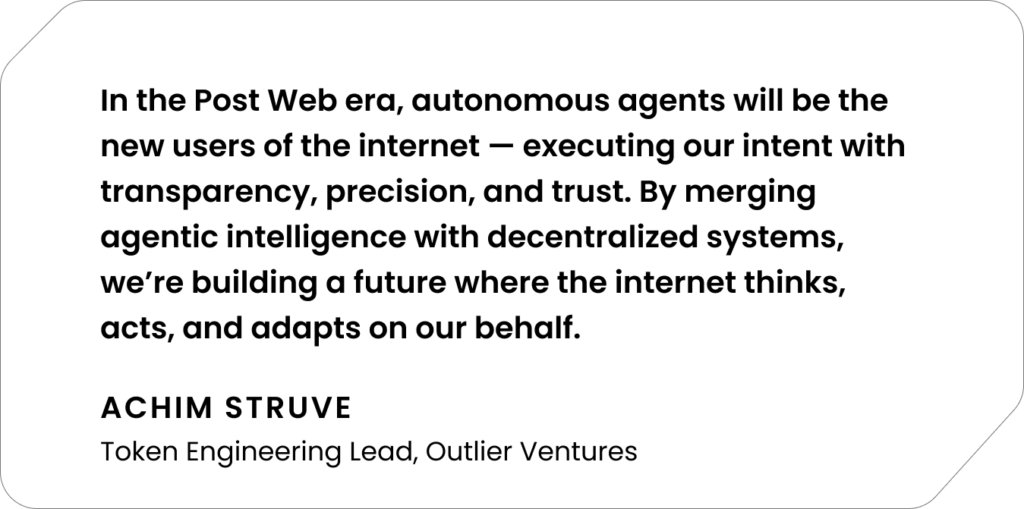
What Is the Agentic Layer?
The agentic layer is a new frontier in The Post Web tech stack. It’s the layer where autonomous agents live, operate, and interface with everything else – from protocols to platforms to physical devices. This is creating a perfect storm for agent adoption.
Founders must understand that applications are no longer built for humans to use, but for agents to interact with via protocols, APIs, smart contracts, and data feeds. As agents become a primary user type, new infrastructure is needed that is secure, verifiable, and efficient.
TL;DR: Why Now? A Perfect Storm for Agent Adoption
As a core component of our Post Web vision, projects that fuse agentic systems with blockchain technologies establish the foundation of this new paradigm. By combining the autonomous capabilities of agents with the trustless capabilities of blockchain, new projects can create dynamically powerful systems that unlock the future of the internet.
- AI Diffusion: AI is rapidly diffusing into every sector of the internet, with autonomous agents becoming increasingly feasible to deploy.
- Mature Web3 Tech Stack: Decentralized infrastructure and applications have reached a point of maturation to effectively support and scale agentic protocols and applications.
- Agentic Innovation: Novel agentic frameworks are enhancing the overall capabilities of agents while accelerating their deployment across the internet.
- Demand for Automation: As technology grows more complex and data volumes soar, users are increasingly seeking autonomous solutions to streamline decision-making.
As we approach the Post Web, advanced AI systems are diffusing rapidly across every layer of the internet and autonomous agents are becoming increasingly more feasible to deploy.
The Agentic Stack Is Already Taking Shape
Over the past decade, the industry has quietly built a stack ready to support agent-based systems, from decentralized storage and compute to programmable protocols and on-chain data access.
This highlights the critical role of distributed ledger technologies to ensure that this new paradigm is transparent, trustless, and verifiable. With novel agentic frameworks enhancing the capabilities of agents, it is becoming simpler and faster to roll out agent-based systems for a wide range of applications. Meanwhile, the surging demand for automation, fueled by the sheer complexity of new technology and the exponential overload of information, uniquely positions agents as indispensable tools for streamlined decision-making. By leveraging the autonomous capabilities of agent-based systems, entirely new applications and markets can emerge, unlocking more fluid and adaptive economic activity, and optimized outcomes in ways previously unattainable.
The rise of agents is unlocking a fundamentally new paradigm for the internet, enabling entirely new markets, coordination mechanisms, and user experiences, and reshaping how economic activity and value are created and exchanged within the internet.
Now, we’re seeing explosive momentum.
Key Trends
Exhibit 2: Developer activity with agentic frameworks by GitHub stars over time. Major Web2 frameworks (AutoGen) and Web3 frameworks (Eliza) have shown strong growth.
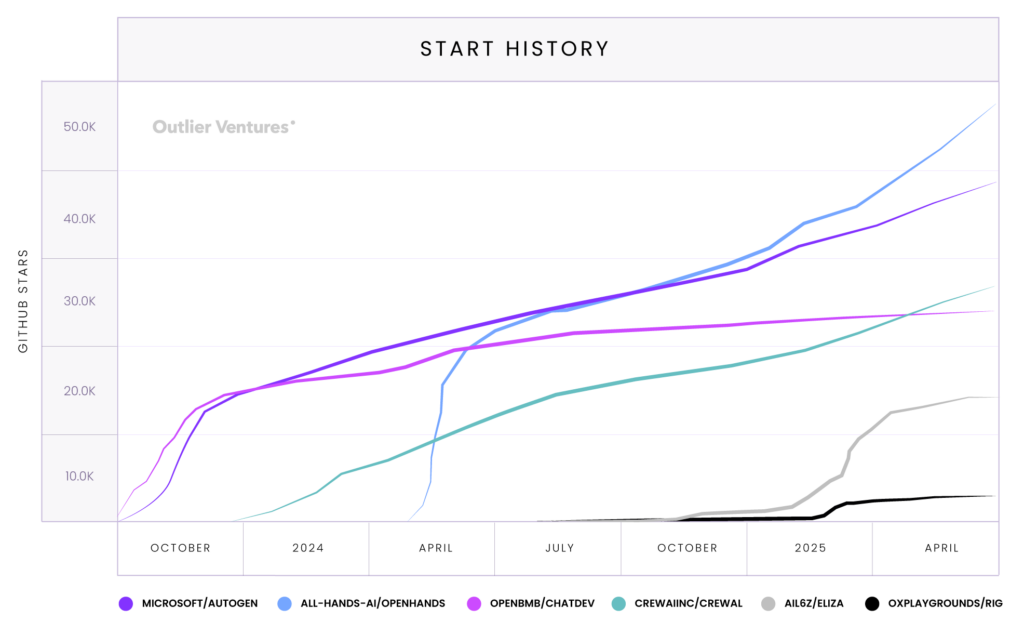
- Agentic Frameworks: Agentic frameworks are providing the foundational tooling to make it easier to create, deploy, and manage AI agents in decentralized envrionments.
Exhibit 3: Below illustrates the total number of AI agents created on leading AI agent marketplaces, demonstrating explosive growth in Q4 2024.

- Agent Marketplaces: Agent marketplaces are emerging as specialzied ecosystems where users can create, deploy, and monetize agents.
- Agentic Tooling: New open standards like Model Context Protocol (MCP) are emerging as core agentic tooling, enabling AI models to securely retrieve external context, opening the door for more composable, context-aware agents.
Exhibit 4: Developer activity of Model Context Protocol (MCP) Servers by GitHub Star. Developer interest grew in January 2025 by 2.75x and in February by 3.75x.
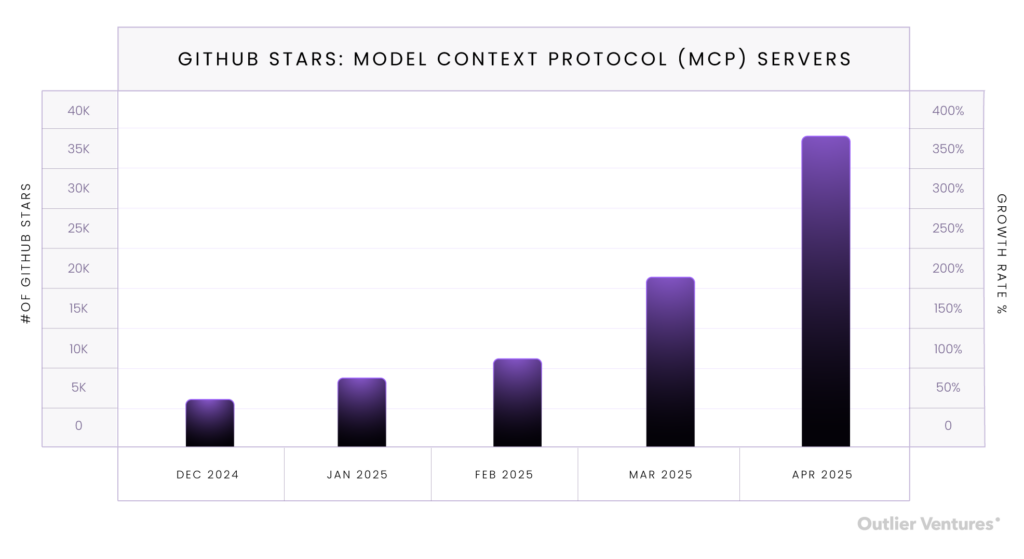
A New Design Space for Founders
So, what should founders build in the agentic internet? Here are three early zones of opportunity:
Utility-Focused Agents
Agentic applications that automate workflows, optimize existing applications, streamline information, and more.
The first wave of agents were largely centered around garnering social attention and speculation of token prices. While emerging agentic marketplaces and frameworks show signs of utility, user expectations have not been exceeded. We believe the next big wave of agentic projects will focus on building tangingle value creation, bridging real-world needs to drive utility. These projects will aim for measurable outcomes, such as automating workflows, optimizing applications, streamlining information, and much more.
Onchain/Offchain integration
Applications and protocols that elegantly integrate onchain and offchain environments with agents, to unlock new performance, productivity, and efficiency.
Agents operating across onchain and offchain environments, leveraging DLT while interacting with external data, are positioned to unlock a new level of agent productivity. Intelligent integration between these layers is essential for effective reasoning, accurate execution, and adaptive performance. By combining the trust guarantees of blockchains with the value of offchain data, agents can make more informed decisions and respond to real-world conditions in real time. The most efficient systems will interact with DLT and offchain environments at optimized points in time, taking into account tradeoffs between trust, cost, and speed. Builders need to increasingly think about DLT as a solution to (i) verify past agent activity and (ii) specify future potential activity.
Multi-Agent Systems
Mutli-agent systems to create elegant solutions around highly-complex decision making and knowledge-intensive applications.
Agentic systems leveraging multi-agent architectures enable collaboration and competition between specialized agents to solve complex problems more efficiently. By distributing tasks across multiple agents, each with distinct roles, goals, or capabilities, these systems can orchestrate and achieve sophisticated outcomes that no single agent could manage alone. This structure allows for dynamic negotiation, adaptive coordination, and emergent behavior, making it ideal for use cases for highly-complex decision making and knowledge-intensive applications.
Building for Agents? Let’s Talk.
If you’re building the tools, infrastructure, or applications that will power this shift to an agentic-driven internet, now’s the time to accelerate.
Post Web Base Camp is our accelerator designed for early-stage teams at the intersection of AI and Web3. We provide funding, hands-on support, deep technical guidance, and a global network of partners to help you go from theory to product faster.
And if you want the rest of this series, delivered straight to your inbox, sign up for our newsletter to stay ahead of the curve.
The next era of the internet won’t be built for people. It’ll be built for agents. Be one of the founders building it.

